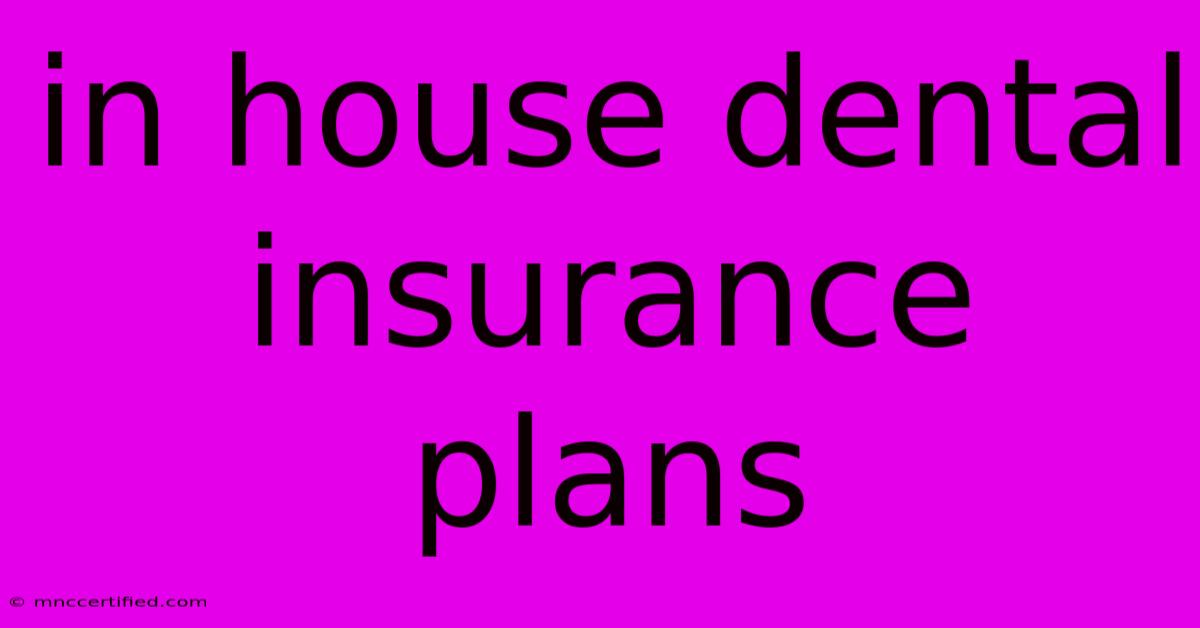In House Dental Insurance Plans

Table of Contents
In-House Dental Insurance Plans: A Comprehensive Guide for Employers
Are you an employer looking to offer a competitive benefits package that attracts and retains top talent? A robust employee benefits program is crucial in today's competitive job market, and dental insurance is a highly sought-after perk. While traditional dental insurance plans involve third-party providers, in-house dental insurance plans offer a unique alternative, allowing businesses to manage their dental benefits internally. This comprehensive guide explores the intricacies of in-house dental plans, their advantages, disadvantages, and factors to consider before implementation.
What are In-House Dental Insurance Plans?
In-house dental insurance plans, also known as self-funded dental plans, are programs where the employer directly pays for employee dental expenses rather than relying on a third-party insurer. The company acts as its own insurance provider, establishing a dedicated fund to cover employee dental needs. Instead of paying premiums to an external company, the employer sets aside funds to meet anticipated dental claims.
Advantages of In-House Dental Insurance Plans
In-house dental plans offer several significant benefits for employers:
-
Cost Savings: While initial setup might require investment, in-house plans can potentially offer long-term cost savings compared to traditional plans. Employers retain greater control over costs and can avoid insurer profit margins.
-
Increased Control and Flexibility: Employers have complete control over plan design, benefits, and eligibility criteria. This allows for tailoring the plan to the specific needs and demographics of their workforce. This flexibility can extend to choosing specific dentists or networks.
-
Improved Employee Satisfaction: A well-designed in-house plan can significantly boost employee morale and loyalty, attracting and retaining valuable employees.
-
Simplified Administration: While initially complex to set up, an in-house plan's administrative burden can be lower than dealing with external insurers, particularly for smaller companies. This streamlining is especially true when leveraging specialized software.
Disadvantages of In-House Dental Insurance Plans
Despite the advantages, in-house dental insurance plans also present certain challenges:
-
High Initial Setup Costs: Establishing an in-house plan necessitates substantial upfront investment in administrative infrastructure, software, and potentially legal counsel.
-
Risk Management: Employers assume the financial risk associated with unexpected high dental claims. This risk can be mitigated through careful planning, budgeting, and possibly establishing a reserve fund.
-
Administrative Burden: Managing claims, negotiating with dentists, and handling administrative tasks requires dedicated personnel and resources. Poor management can lead to inefficiencies.
-
Compliance: Employers are responsible for ensuring compliance with all relevant federal and state regulations regarding employee benefits and healthcare.
Key Considerations Before Implementing an In-House Dental Plan
Before implementing an in-house dental insurance plan, employers should carefully consider the following factors:
-
Employee Demographics: Understand the dental needs and health profiles of your workforce to accurately project claims and budget accordingly.
-
Budgeting and Financial Planning: Develop a comprehensive budget that accounts for all anticipated costs, including administrative expenses, claims, and potential unexpected high-cost treatments.
-
Legal and Regulatory Compliance: Ensure compliance with all applicable laws and regulations, including ERISA (Employee Retirement Income Security Act) requirements.
-
Administrative Capabilities: Assess your company's internal capacity to manage the administrative complexities of an in-house plan. Consider outsourcing certain functions if needed.
In-House Dental Plans vs. Traditional Dental Insurance: A Comparison
| Feature | In-House Dental Plan | Traditional Dental Insurance |
|---|---|---|
| Cost | Potentially lower long-term, higher upfront costs | Predictable monthly premiums |
| Control | High | Low |
| Flexibility | High | Limited |
| Risk | Assumed by employer | Assumed by insurance company |
| Administration | Requires internal resources or outsourcing | Managed by the insurance company |
Conclusion: Is an In-House Dental Insurance Plan Right for Your Business?
The decision of whether to implement an in-house dental insurance plan depends on numerous factors specific to your company. Weighing the advantages and disadvantages carefully and conducting a thorough cost-benefit analysis is crucial. For larger companies with sufficient resources and administrative capacity, an in-house plan may offer substantial long-term benefits. Smaller companies may find traditional insurance plans a more manageable option. Consulting with benefits specialists and legal counsel is highly recommended before making a decision. Proper planning and execution are key to the success of any in-house dental insurance program.

Thank you for visiting our website wich cover about In House Dental Insurance Plans. We hope the information provided has been useful to you. Feel free to contact us if you have any questions or need further assistance. See you next time and dont miss to bookmark.
Featured Posts
-
One In Three Share Bedrooms Wales
Nov 23, 2024
-
Is Bond Information Public Record
Nov 23, 2024
-
Native American Dental Insurance
Nov 23, 2024
-
Missing Stoughton Children Found Safe
Nov 23, 2024
-
Holiday Mc Donald S Grinch Meal Excludes Us
Nov 23, 2024